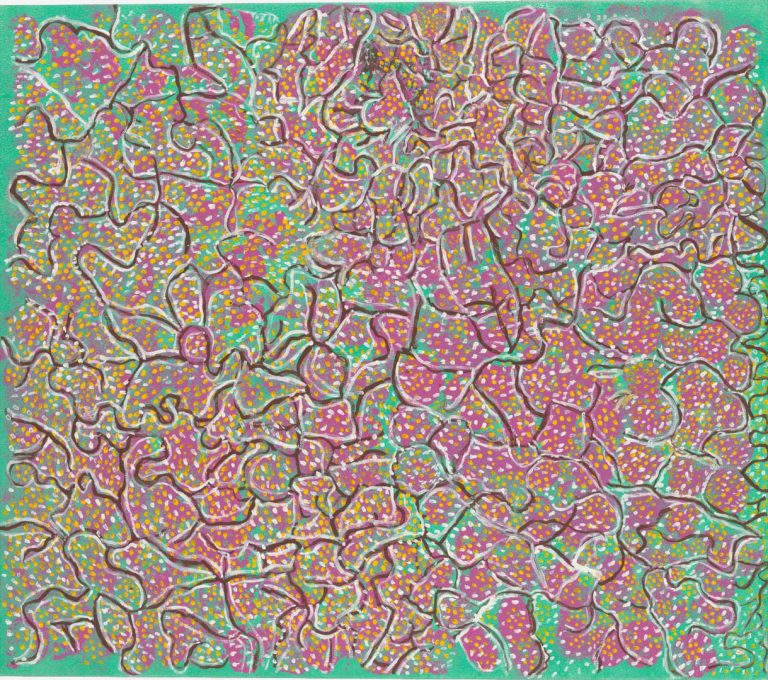We acknowledge the Traditional Owners of the land on which the Queensland Art Gallery | Gallery of Modern Art stands and recognise the creative contribution First Australians make to the art and culture of this country.

Mavis Ngallametta / Kugu-Uwanh people, Putch clan / Australia 1944–2019 / Mo’Yakal (White and yellow wattles in flower) 2008 / Synthetic polymer paint on linen / 84 x 96cm / Gift of the artist through the Queensland Art Gallery | Gallery of Modern Art Foundation 2015. Donated through the Australian Government’s Cultural Gifts Program / Collection: Queensland Art Gallery | Gallery of Modern Art / © The Estate of Mavis Ngallametta
Mavis NGALLAMETTAMo’Yakal (White and yellow wattles in flower) 2008
Not Currently on Display
White and yellow wattle flowers are all around starting in the Easter month of April with white ones, and then finishing with the yellow ones around June.1
Mavis Ngallametta’s experience as a master weaver greatly informed her painting practice. Just as a weaver envisions the final form of their work and, with every action, works towards it, Mavis pictured her compositions, working towards the final form carefully, one gesture at a time. In her thoughts, dreams and memories, her paintings would appear, and her hand, informed by decades of cultural practice, would translate these onto the canvas. In her paintings, countless interconnecting lines entangle the elements of the composition, representing the paths and waterways that wind through country, and resembling weavings.
Endnotes:
1. Mavis Ngallametta, quoted in QAGOMA Research Library Collection Artist File, 2015.
Mavis Ngallametta was born in 1944 into the Marbunt family of the Kugu people on their traditional country, near the Kendall River in west Cape York Peninsula. An elder of the Putch clan and a cultural leader of the Wik and Kugu people of Aurukun, Mavis is remembered for her rich legacy to her community and to art and culture nationally. Mavis embarked on her journey to become a painter relatively late in life — she did not pick up a paintbrush until 2008, at the age of 64.
Mavis lived a traditional life in the bush until she was around five, when her family was moved to the Presbyterian Mission at Aurukun. She maintained connections with family members and elders despite this upheaval, and, in time, learnt to weave dilly bags and fruit bowls made from cabbage palm and pandanus. As a result, she was first recognised for her weaving using traditional materials, which later expanded to include recycled driftnets and marine debris.
In 2008, Ngallametta began making small paintings depicting important cultural sites, and from 2010, her works grew in scale. Mavis tended to depict sites of personal significance in her paintings. Recurring subjects include Ikalath, where she collected white clay; her traditional country of Kendall River; Wutan, a camping site belonging to her adopted son Edgar; and various pamp, or swamps, dotted around Aurukun.
Discussion Questions
1. If Mo’Yakal (White and yellow wattles in flower) was a three-dimensional, woven form, what do you think it would look like?
2. Compare Mavis Ngallametta’s works to those of Regina Wilson, another master weaver who later shifted her practice into painting. How has Wilson’s experience as a weaver influenced her painting? In what ways does her approach differ to that of Ngallametta’s?
Classroom Activities
1. Using only your memories, create a painting that shows a bird’s-eye view of a place that is important to you.
2. Imagine that you are standing on the ground in the centre of Mavis Ngallametta’s Mo’Yakal (White and yellow wattles in flower). Draw the same landscape using a traditional, horizontal perspective.